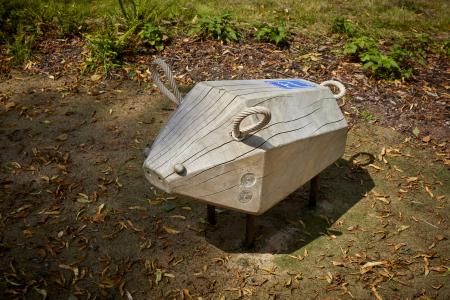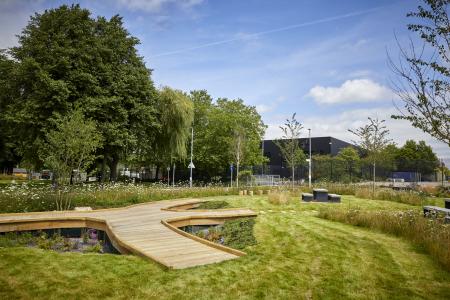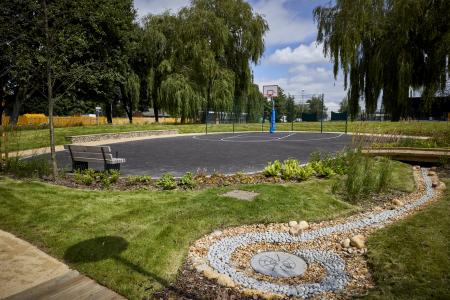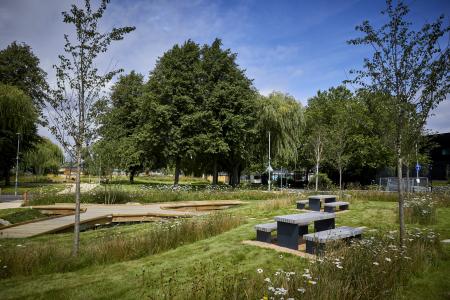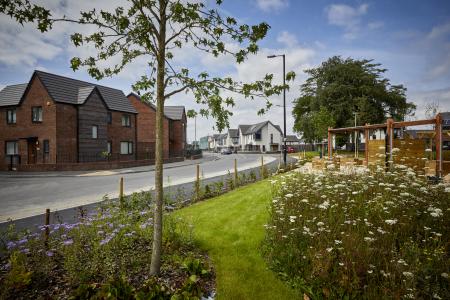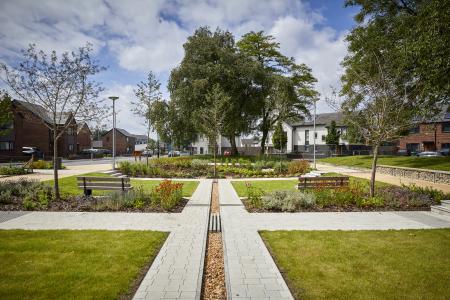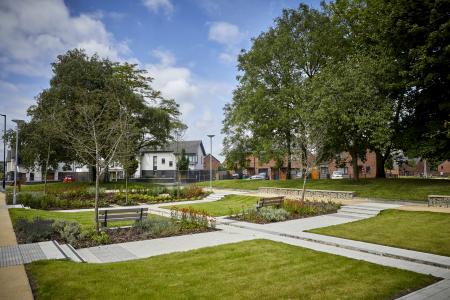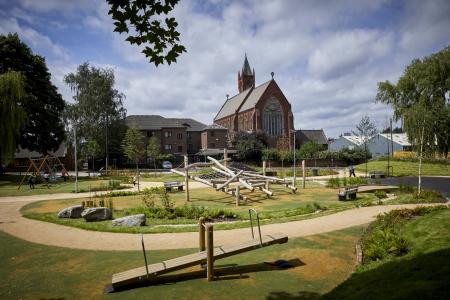
Area characterisation:
The site area identified for the GrowGreen Project was in West Gorton, a city suburb in Manchester within the North West of England, UK. Located three kilometres to the south east of the city centre, West Gorton is a former heavy industrial area which has suffered from several decades of deindustrialisation and neglect, high levels of social deprivation, negative health indicators, poor quality housing, and an increased level of unemployment compared to local and national indicators. The Demonstration Project site is on land managed by Manchester City Council in an area undergoing significant regeneration, including new housing and improved infrastructure. The proposal to create a new space for public recreation provided an opportunity to develop NbS for the GrowGreen project and to evaluate how it can mitigate climate change, as well as supporting wider socio-economic benefits.
The site originally consisted of an unattractive park area with outdated play equipment and an overgrown brownfield site as a consequence of housing demolition.
Objective:
- To demonstrate the potential of nature-based solutions to reduce heat stress, manage water and improve wellbeing and social cohesion
- To engage local people in designing nature-based solutions that meet their needs
- To develop an effective strategy for nature-based solutions across the city
Images
Financing:
The total construction costs were approximately €1.4 million. The majority of this was funded by the EC (through the GrowGreen H2020 project). The costs and benefits of the Manchester investment were estimated over a 25 year period, drawing on monitoring data and published literature, and suggest the project investment of around EUR 2 million produces net benefits of EUR 3.3 million and a benefit-cost ratio of 2.5.
Potential impacts/benefits:
Impacts
• Establish an evidence base that NbS in cities provides a cost-effective, sustainable, and replicable means of increasing urban water and climate resilience.
• Provide information on other co-benefits, including improvements in health and wellbeing, social cohesion, biodiversity, and socio-economic indicators.
• Create a ‘Living Lab’ to encourage investment and development of NbS in other parts of Manchester and neighbouring districts.
• Influence the city’s green infrastructure strategy
Benefits
• Surface water run off reduction
- Average volume reduction = 97.6%
- Average peak flow reduction = 98.1%
- Average rainfall run off coefficient = 0.015
• Health and well-being improvements
There have been significant increases in the number of people using the space to undertake physical activity. Physical benefits in terms of added years of lives amount to EUR 140,000 per year. As regards to avoided healthcare costs, savings amount to EUR 125,000 per year
• Biodiversity Net Gain
There have been significant increases in species, number of trees, shrubs and ground level vegetation.
• Community engagement in NbS
There have been significant increases in the social engagement and cohesion in West Gorton.
• Positive economic impact
A forecasted benefit-cost ratio of 2.5 over 25 years. Direct employment created by the investment amount to 13.1 FTE/year. It was estimated that the park enhanced the value of nearby properties by EUR 1.86 million overall.
Actions:
The West Gorton Community Park is a park that “drinks water”, based on the sponge city concept. It aimed to demonstrate how NbS can improve resilience to climate change and enhance bio-diversity whilst having a positive impact on the social, health and well-being of residents.
Park design: The redeveloped park is around the size of three football pitches and is composed by three areas: the Woodland, the Meadow, and the Community City Plaza. In the three parts of the park there is also an underlying drainage design. The park includes a large play area with permeable safety surfacing and a basketball court with a non-permeable surface which re-directs rainfall towards the drainage channel into a bio-retention tree-pit. Other NbS features include a rain garden, swales and check dams to slow down the water flow.
Transferability of result:
The demonstrator contributed to the evidence base of NbS in cities.
The city of Manchester witnessed an evolution from a policy perspective, towards a better integration of the role of the natural environment. Throughout the last years, Manchester’s Local Plan (2009) shifted the focus on both green and blue infrastructure for climate resilience, and successively led to the development of the Manchester Green and Blue Infrastructure Strategy in 2015, then revised in 2021. Also, other important strategies were made, such as “Our Rivers, Our City” and “My wild city” which were produced as part of the GrowGreen project.
GrowGreen has been the catalyst for all these actions, through the implementation of projects on the ground which are contributing to improving the quality and function of the city’s landscape towards more climate resilience.
Lessons learnt:
• Design - Projects need to have a clear scope and ensure engagement of relevant stakeholders; specialised knowledge is required for NbS implementation (e.g. contractors), and may be supported by standards for materials and frameworks for procedures;
• Stakeholders engagement - Involving local staff to help facilitate engagement can ensure the process benefits from local perspectives and inputs; Involving the community in the consultation process has resulted in greater engagement
• Construction - statutory approvals should be considered; careful planning, and detailed site testing were used to mitigate unexpected technical issues;
• Monitoring and impact evaluation – smart monitoring with sensors was applied, as well as other assessment methodologies;
• Management and maintenance - Senior leadership is required to support NbS, and budgetary challenges require creative thinking to address maintenance issues;
Organisations:
Manchester City Council, Manchester University, Groundwork, Manchester Climate Change Agency
Client:
Manchester City Council
Design team:
Arup, BDP
Contacts:
Grainne Bradley
email : grainne.bradley@manchester.gov.uk
Michelle Oddy
email : michelle.oddy@manchester.gov.uk
Global goals:
-
3. Good Health and well being
-
6. Clean water and sanitation
-
11. Sustainable cities and communities
-
13. Climate action
-
15. Life on land
NBS goals:
- Enhancing sustainable urbanization
- Developing climate change mitigation
- Developing climate change adaptation
- Improving risk management and resilience
- Urban regeneration through nature-based solutions
- Nature-based solutions for improving well-being in urban areas
NBS benefits:
- Developing climate change adaptation; improving risk management and resilience
- Flood peak reduction
- Increase infiltration / Water storage
- Increasing infiltration
- Reduce flood risk
- Reduce load to sewer system
- Reduce run-off
- Developing climate change mitigation
- Greater ecological connectivity across urban regenerated sites
- Improve connectivity and functionality of green and blue infrastructures
- Increase Biodiversity
- Increase quality and quantity of green and blue infrastructures
- Enhancing sustainable urbanisation
- Changing image of the urban environment
- Improve water quality
- Increase accessibility to green open spaces
- Increase amount of green open spaces for residents
- Increase awareness of NBS solution & their effectiveness and co benefits
- Increase population & infrastructures protected by NBS
- Increase social interaction
- Increase stakeholder awareness & knowledge about NBS
- Increase well-being
- Increase willingness to invest in NBS
- Provision of health benefits
- Reduce costs for water treatments
- Social inclusion
- Social learning about location & importance of NBS
